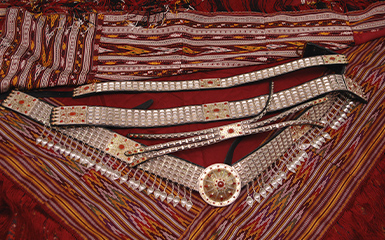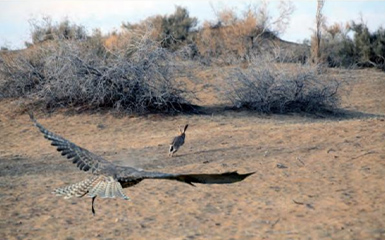Turkmen jewellery art is an integral part of the national cultural heritage. The rich decoration of the national costume with jewellery was introduced on the territory of present-day Turkmenistan a very long time ago, probably at least two millennia ago. The terracotta statues of goddesses from Margiana (last centuries BC and early CE) depict numerous pendants on clothes and complex high headdresses in the form we see nowadays. The archaeological findings in other ancient settlements on the territory of Turkmenistan also evidence this fact. A unique collection of jewellery is exhibited in the State Museum of the State Cultural Centre of Turkmenistan. The works by the Turkmen jewellers are included in the expositions of the world’s best museum collections.
Production of the Turkmen zergers (jewellers) differs in beauty and harmony, attracts with the originality, symmetry of patterns and unique national ornament. The masters have passed down their secrets from generation to generation over the centuries. Jewellery is an integral part of the life of the Turkmen people. Women, children, as well as men, wore the personal ornaments. Jewellery was used to decorate the Ahalteke horses as a sign of respect for war horses and their protection from evil and diseases. These amazing products served both as a decorative adornment to the dress, and as miraculous amulets. The jewellery reflects the symbols inherent in the national art especially brightly and excitingly. Shape, arrangement of stones, proportions, composition, and ornament – everything had a magical meaning. According to the ancient beliefs, silver had healing and protective properties. Semi-precious stones, including in turquoise, corals, carnelian, and nephrite, were most frequently used for decoration. However, the favourite stone is carnelian, the stone that brings abundance, happiness and peace to the house, and health and protection from the evil to its owner.
It is hard to enumerate all the types of women's jewellery. There are many dozens of them for different purposes. Women wear them in accordance with marital status, age, suit, as conceivable and inconceivable elements.


Girls and young women adorned their heads, chests, necks, arms, plaits and clothes with massive jewellery. Adult women preferred lightweight and silver jewellery. Old ladies wore only two amulets.
Women's jewellery often resembles the armour of ancient soldiers. Some works are surprisingly similar to the helmet of an ancient knight, and the others are associated with chain mail that protects against arrows and spears. The massive bracelets, covering the arm from wrist to elbow, are identical in shape to steel armlets.
The traditional wedding dress weighed 20 kilogrammes. The future mother-in-law gave the bride an ornament in the shape of two welded metal hearts. The number of curls at the bottom of the ornament symbolized the expected or desired number of children.
Children's amulet in the form of a stylized bow and arrow, symbolizing courage, was fixed onto the back of the robe for the boy to grow up strong and brave. Men wore only a silver belt for a dagger.
From late 19th century, the Turkmen women cannot dispense with a brooch-clasp called ‘gulyaka’, which is fastened to the collar of the dress. In everyday life, women wear the ancient amulets – fancy plates with coins.


The art of decorating horses requires special attention. It has a long history. Even before the Common Era, additional ornate details of ammunition were very popular. The love of the Turkmen people for horses resulted in the adornment created in an effort to make this animal even more beautiful. The decoration, amazing in the richness and beauty, was designed for horses. The equestrian equipment, called ‘at shayy’, includes a bridle, breast collar, head ornament and several collars. Traditionally, the bridle consisted of narrow straps with silver tablets and insets, as well as carnelian at the junction points.
To date, the Turkmen jewellers create the national masterpieces and continue the traditions of the experts of the past. The travellers can admire jewellery in the country's museums and purchase it in shopping centres, specialized stores or, according to the ancient tradition, in bazaars in Turkmenistan.
Akhal-teke horse